高中英语句子成分划分详解(全)
- 格式:doc
- 大小:106.00 KB
- 文档页数:17
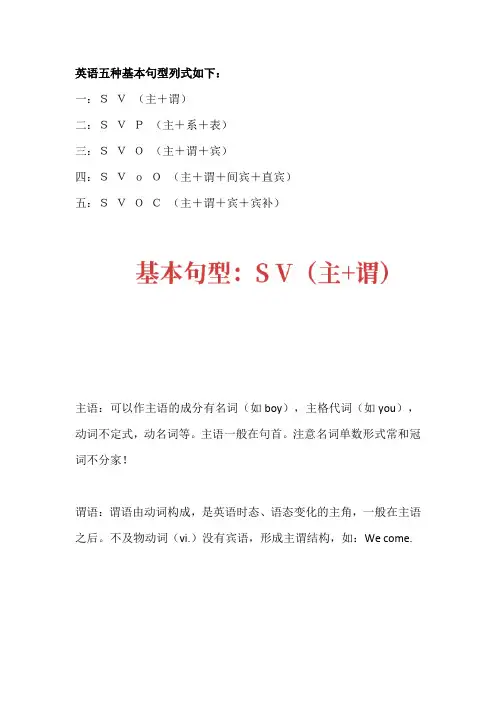
英语五种基本句型列式如下:一:SV(主+谓)二:SVP(主+系+表)三:SVO(主+谓+宾)四:SVoO(主+谓+间宾+直宾)五:SVOC(主+谓+宾+宾补)主语:可以作主语的成分有名词(如boy),主格代词(如you),动词不定式,动名词等。
主语一般在句首。
注意名词单数形式常和冠词不分家!谓语:谓语由动词构成,是英语时态、语态变化的主角,一般在主语之后。
不及物动词(vi.)没有宾语,形成主谓结构,如:We come.此句型的句子有一个共同特点,即句子的谓语动词都能表达完整的意思。
这类动词叫做不及物动词,后面可以跟副词、介词短语、状语从句等。
S│ V(不及物动词)1. The sun │was shining.太阳在照耀着。
2. The moon │rose. 月亮升起了。
3. The universe │remains. 宇宙长存。
4. We all │breathe, eat, and drink. 我们大家都呼吸、吃和喝。
5. Who │cares? 管它呢?6. What he said │does not matter. 他所讲的没有什么关系。
7. They │talked for half an hour. 他们谈了半个小时。
8. The pen │writes smoothly 这支笔书写流利。
此句型的句子有一个共同的特点:句子谓语动词都不能表达一个完整的意思,必须加上一个表明主语身份或状态的表语构成复合谓语,才能表达完整的意思。
这类动词叫做连系动词。
系动词分两类:be, look, keep, seem等属一类,表示情况;get, grow, become, turn等属另一类,表示变化。
be 本身没有什么意义,只起连系主语和表语的作用。
其它系动词仍保持其部分词义。
感官动词多可用作联系动词:look well/面色好,sound nice/听起来不错,feel good/感觉好,smell bad/难闻S│V(是系动词)│ P1. This │is │an English-Chinese dictionary.这是本英汉辞典。
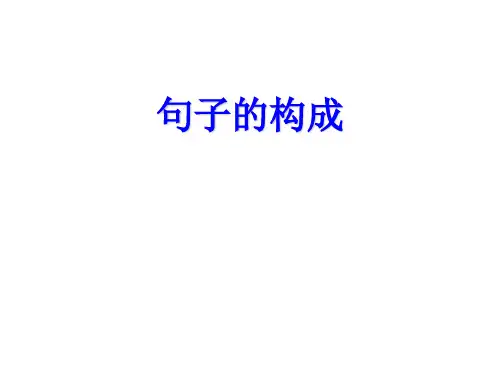
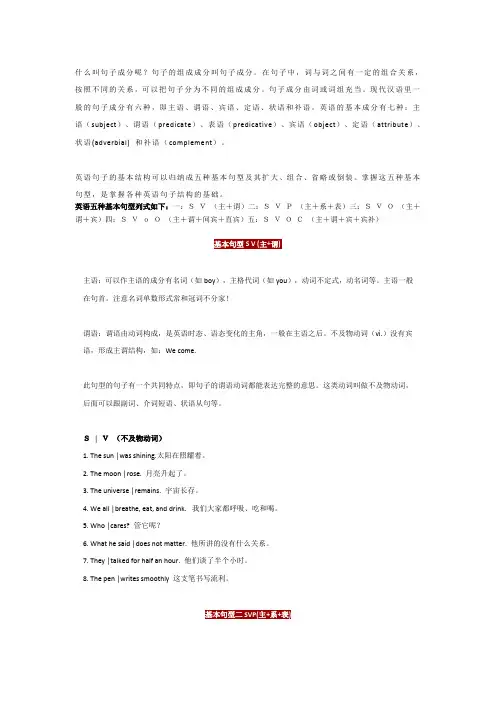
什么叫句子成分呢?句子的组成成分叫句子成分。
在句子中,词与词之间有一定的组合关系,按照不同的关系,可以把句子分为不同的组成成分。
句子成分由词或词组充当。
现代汉语里一般的句子成分有六种,即主语、谓语、宾语、定语、状语和补语。
英语的基本成分有七种:主语(subject)、谓语(predicate)、表语(predicative)、宾语(object)、定语(attribute)、状语(adverbial) 和补语(complement)。
英语句子的基本结构可以归纳成五种基本句型及其扩大、组合、省略或倒装。
掌握这五种基本句型,是掌握各种英语句子结构的基础。
英语五种基本句型列式如下:一:SV(主+谓)二:SVP(主+系+表)三:SVO(主+谓+宾)四:SVoO(主+谓+间宾+直宾)五:SVOC(主+谓+宾+宾补)主语:可以作主语的成分有名词(如boy),主格代词(如you),动词不定式,动名词等。
主语一般在句首。
注意名词单数形式常和冠词不分家!谓语:谓语由动词构成,是英语时态、语态变化的主角,一般在主语之后。
不及物动词(vi.)没有宾语,形成主谓结构,如:We come.此句型的句子有一个共同特点,即句子的谓语动词都能表达完整的意思。
这类动词叫做不及物动词,后面可以跟副词、介词短语、状语从句等。
S│ V(不及物动词)1. The sun │was shining.太阳在照耀着。
2. The moon │rose. 月亮升起了。
3. The universe │remains. 宇宙长存。
4. We all │breathe, eat, and dri nk. 我们大家都呼吸、吃和喝。
5. Who │cares? 管它呢?6. What he said │does not matter. 他所讲的没有什么关系。
7. They │talked for half an hour. 他们谈了半个小时。
8. The pen │writes smoothly 这支笔书写流利。

可编辑修改精选全文完整版英语句子成分一、英语句子的成分组成句子的各个部分叫作句子的成分。
句子成分主要包括主语、谓语、宾语、表语、宾语补足语、定语和状语。
主语和谓语是句子的主体部分。
1)主语subject主语是一个句子的主体,是全句叙述的对象,是句子要说明的人或事物,即表示句子所说的“是什么”或“是谁”,常由名词、代词、动名词或动词不定式等担任,一般位于句首。
The girl can sing many English songs.We are students. / This is my pen. Yours is on the desk.The blind need more help.To speak loudly in public is not polite.Smoking is bad for your health.2)谓语predicate谓语是对主语加以陈述,表示主语的动作或状态,常由动词担任,一般位于主语之后。
谓语有时态和语态的变化,且要和主语在人称和数上保持一致。
I love you. You hate me. You hurt my heart.I have an English-Chinese dictionary. He has one too.We can play the piano.She is talking with her sister. / I have seen this man before.3)宾语object宾语是谓语动词所涉及的对象,是谓语动词所表示动作的对象或承受者。
常由名词、代词、动名词或动词不定式等担任,一般位于谓语动词(及物动词)或介词之后。
He is doing his homework. / I saw a plane in the sky just now.They did nothing this morning. / I met him on my way home.She wants to go home.We enjoy playing football.【注意】:某些及物动词之后要求有双宾语,即直接宾语和间接宾语,直接宾语指物,间接宾语指人。
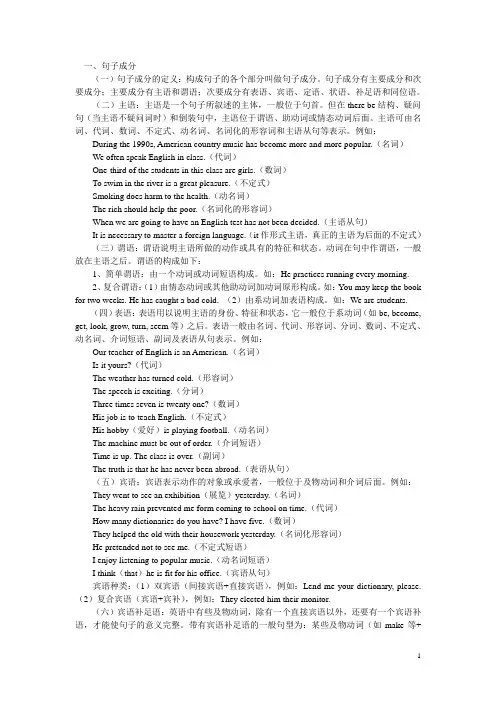
一、句子成分(一)句子成分的定义:构成句子的各个部分叫做句子成分。
句子成分有主要成分和次要成分;主要成分有主语和谓语;次要成分有表语、宾语、定语、状语、补足语和同位语。
(二)主语:主语是一个句子所叙述的主体,一般位于句首。
但在there be结构、疑问句(当主语不疑问词时)和倒装句中,主语位于谓语、助动词或情态动词后面。
主语可由名词、代词、数词、不定式、动名词、名词化的形容词和主语从句等表示。
例如:During the 1990s, American country music has become more and more popular.(名词)We often speak English in class.(代词)One-third of the students in this class are girls.(数词)To swim in the river is a great pleasure.(不定式)Smoking does harm to the health.(动名词)The rich should help the poor.(名词化的形容词)When we are going to have an English test has not been decided.(主语从句)It is necessary to master a foreign language.(it作形式主语,真正的主语为后面的不定式)(三)谓语:谓语说明主语所做的动作或具有的特征和状态。
动词在句中作谓语,一般放在主语之后。
谓语的构成如下:1、简单谓语:由一个动词或动词短语构成。
如:He practices running every morning.2、复合谓语:(1)由情态动词或其他助动词加动词原形构成。
如:You may keep the book for two weeks. He has caught a bad cold. (2)由系动词加表语构成。
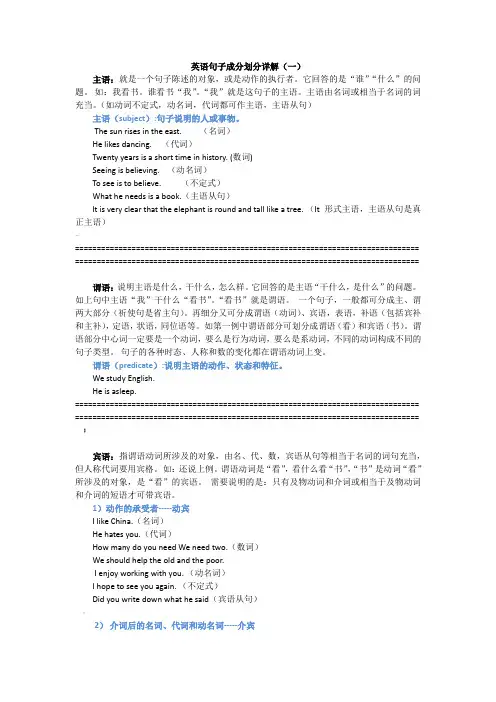
英语句子成分划分详解(一)主语:就是一个句子陈述的对象,或是动作的执行者。
它回答的是“谁”“什么”的问题。
如:我看书。
谁看书“我”。
“我”就是这句子的主语。
主语由名词或相当于名词的词充当。
(如动词不定式,动名词,代词都可作主语,主语从句)主语(subject):句子说明的人或事物。
The sun rises in the east. (名词)He likes dancing. (代词)Twenty years is a short time in history. (数词)Seeing is believing. (动名词)To see is to believe. (不定式)What he needs is a book.(主语从句)It is very clear that the elephant is round and tall like a tree. (It形式主语,主语从句是真正主语)—=============================================================================== ===============================================================================谓语:说明主语是什么,干什么,怎么样。
它回答的是主语“干什么,是什么”的问题。
如上句中主语“我”干什么“看书”。
“看书”就是谓语。
一个句子,一般都可分成主、谓两大部分(祈使句是省主句)。
再细分又可分成谓语(动词)、宾语,表语,补语(包括宾补和主补),定语,状语,同位语等。
如第一例中谓语部分可划分成谓语(看)和宾语(书)。
谓语部分中心词一定要是一个动词,要么是行为动词,要么是系动词,不同的动词构成不同的句子类型。
句子的各种时态、人称和数的变化都在谓语动词上变。
谓语(predicate):说明主语的动作、状态和特征。
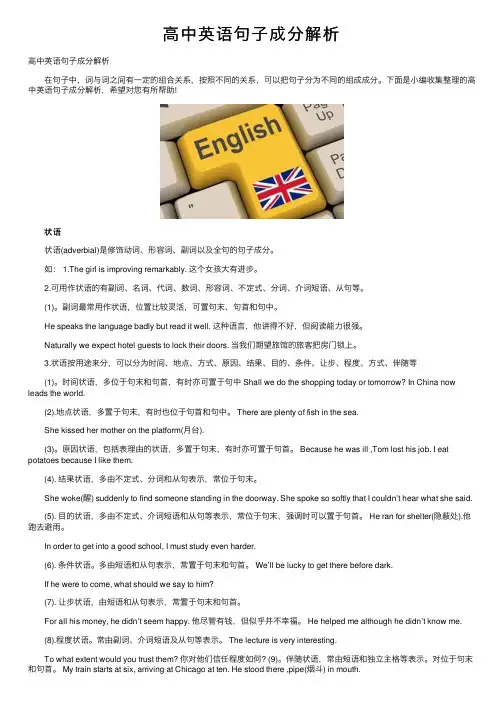
⾼中英语句⼦成分解析⾼中英语句⼦成分解析 在句⼦中,词与词之间有⼀定的组合关系,按照不同的关系,可以把句⼦分为不同的组成成分。
下⾯是⼩编收集整理的⾼中英语句⼦成分解析,希望对您有所帮助!状语 状语 状语(adverbial)是修饰动词、形容词、副词以及全句的句⼦成分。
如: 1.The girl is improving remarkably. 这个⼥孩⼤有进步。
2.可⽤作状语的有副词、名词、代词、数词、形容词、不定式、分词、介词短语、从句等。
(1)。
副词最常⽤作状语,位置⽐较灵活,可置句末、句⾸和句中。
He speaks the language badly but read it well. 这种语⾔,他讲得不好,但阅读能⼒很强。
Naturally we expect hotel guests to lock their doors. 当我们期望旅馆的旅客把房门锁上。
3.状语按⽤途来分,可以分为时间、地点、⽅式、原因、结果、⽬的、条件、让步、程度、⽅式、伴随等 (1)。
时间状语,多位于句末和句⾸,有时亦可置于句中 Shall we do the shopping today or tomorrow? In China now leads the world. (2).地点状语,多置于句末,有时也位于句⾸和句中。
There are plenty of fish in the sea. She kissed her mother on the platform(⽉台). (3)。
原因状语,包括表理由的状语,多置于句末,有时亦可置于句⾸。
Because he was ill ,Tom lost his job. I eat potatoes because I like them. (4). 结果状语,多由不定式、分词和从句表⽰,常位于句末。
She woke(醒) suddenly to find someone standing in the doorway. She spoke so softly that I couldn’t hear what she said. (5). ⽬的状语,多由不定式、介词短语和从句等表⽰,常位于句末,强调时可以置于句⾸。
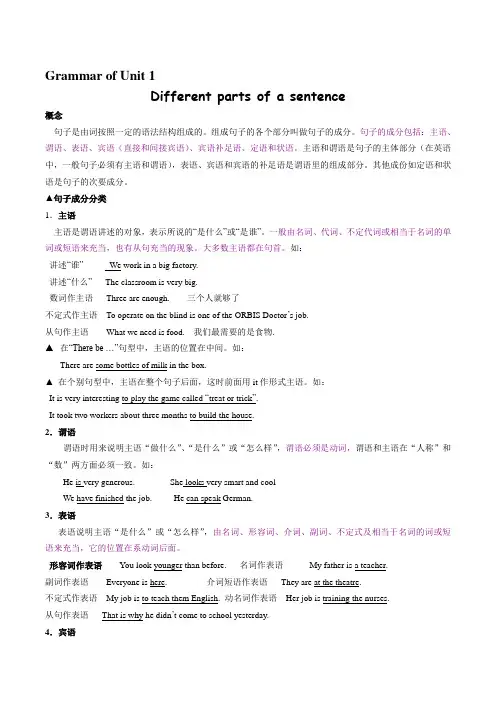
Grammar of Unit 1Different parts of a sentence概念句子是由词按照一定的语法结构组成的。
组成句子的各个部分叫做句子的成分。
句子的成分包括:主语、谓语、表语、宾语(直接和间接宾语)、宾语补足语、定语和状语。
主语和谓语是句子的主体部分(在英语中,一般句子必须有主语和谓语),表语、宾语和宾语的补足语是谓语里的组成部分。
其他成份如定语和状语是句子的次要成分。
▲句子成分分类1.主语主语是谓语讲述的对象,表示所说的“是什么”或“是谁”。
一般由名词、代词、不定代词或相当于名词的单词或短语来充当,也有从句充当的现象。
大多数主语都在句首。
如:讲述“谁”We work in a big factory.讲述“什么”The classroom is very big.数词作主语Three are enough. 三个人就够了不定式作主语To operate on the blind is one of the ORBIS Doctor’s job.从句作主语What we need is food. 我们最需要的是食物.▲在“There be …”句型中,主语的位置在中间。
如:There are some bottles of milk in the box.▲在个别句型中,主语在整个句子后面,这时前面用it作形式主语。
如:It is very interesting to play the game called “treat or trick”.It took two workers about three months to build the house.2.谓语谓语时用来说明主语“做什么”、“是什么”或“怎么样”,谓语必须是动词,谓语和主语在“人称”和“数”两方面必须一致。
如:He is very generous. She looks very smart and coolWe have finished the job. He can speak German.3.表语表语说明主语“是什么”或“怎么样”,由名词、形容词、介词、副词、不定式及相当于名词的词或短语来充当,它的位置在系动词后面。
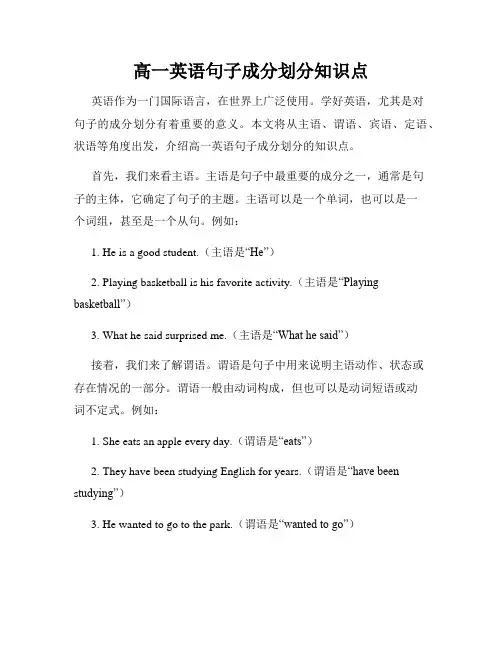
高一英语句子成分划分知识点英语作为一门国际语言,在世界上广泛使用。
学好英语,尤其是对句子的成分划分有着重要的意义。
本文将从主语、谓语、宾语、定语、状语等角度出发,介绍高一英语句子成分划分的知识点。
首先,我们来看主语。
主语是句子中最重要的成分之一,通常是句子的主体,它确定了句子的主题。
主语可以是一个单词,也可以是一个词组,甚至是一个从句。
例如:1. He is a good student.(主语是“He”)2. Playing basketball is his favorite activity.(主语是“Playing basketball”)3. What he said surprised me.(主语是“What he said”)接着,我们来了解谓语。
谓语是句子中用来说明主语动作、状态或存在情况的一部分。
谓语一般由动词构成,但也可以是动词短语或动词不定式。
例如:1. She eats an apple every day.(谓语是“eats”)2. They have been studying English for years.(谓语是“have beens tudying”)3. He wanted to go to the park.(谓语是“wanted to go”)然后,我们来研究宾语。
宾语是句子中的动作对象,它一般接在及物动词之后,帮助说明动作的目标或结果。
宾语可以是一个名词、代词、名词短语或从句。
例如:1. I bought a book yesterday.(宾语是“a book”)2. She took pictures of the beautiful scenery.(宾语是“pictures of the beautiful sc enery”)3. Do you know what time it is?(宾语是“what time it is”)接下来,我们来讨论定语。
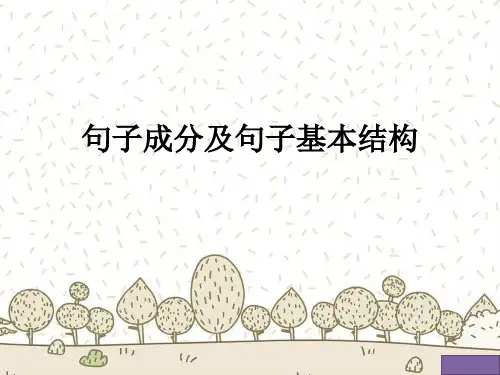
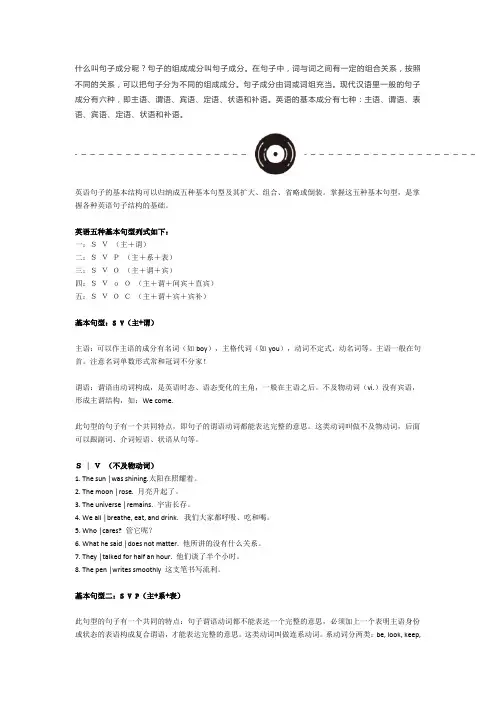
什么叫句子成分呢?句子的组成成分叫句子成分。
在句子中,词与词之间有一定的组合关系,按照不同的关系,可以把句子分为不同的组成成分。
句子成分由词或词组充当。
现代汉语里一般的句子成分有六种,即主语、谓语、宾语、定语、状语和补语。
英语的基本成分有七种:主语、谓语、表语、宾语、定语、状语和补语。
英语句子的基本结构可以归纳成五种基本句型及其扩大、组合、省略或倒装。
掌握这五种基本句型,是掌握各种英语句子结构的基础。
英语五种基本句型列式如下:一:SV(主+谓)二:SVP(主+系+表)三:SVO(主+谓+宾)四:SVoO(主+谓+间宾+直宾)五:SVOC(主+谓+宾+宾补)基本句型:S V(主+谓)主语:可以作主语的成分有名词(如boy),主格代词(如you),动词不定式,动名词等。
主语一般在句首。
注意名词单数形式常和冠词不分家!谓语:谓语由动词构成,是英语时态、语态变化的主角,一般在主语之后。
不及物动词(vi.)没有宾语,形成主谓结构,如:We come.此句型的句子有一个共同特点,即句子的谓语动词都能表达完整的意思。
这类动词叫做不及物动词,后面可以跟副词、介词短语、状语从句等。
S│ V(不及物动词)1. The sun │was shining.太阳在照耀着。
2. The moon │rose. 月亮升起了。
3. The universe │remains. 宇宙长存。
4. We all │breathe, eat, and drink. 我们大家都呼吸、吃和喝。
5. Who │cares? 管它呢?6. What he said │does not matter. 他所讲的没有什么关系。
7. They │talked for half an hour. 他们谈了半个小时。
8. The pen │writes smoothly 这支笔书写流利。
基本句型二:S V P(主+系+表)此句型的句子有一个共同的特点:句子谓语动词都不能表达一个完整的意思,必须加上一个表明主语身份或状态的表语构成复合谓语,才能表达完整的意思。
Grammar of Unit 1Different parts of a sentence概念句子是由词按照一定的语法结构组成的。
组成句子的各个部分叫做句子的成分。
句子的成分包括:主语、谓语、表语、宾语(直接和间接宾语)、宾语补足语、定语和状语。
主语和谓语是句子的主体部分(在英语中,一般句子必须有主语和谓语),表语、宾语和宾语的补足语是谓语里的组成部分。
其他成份如定语和状语是句子的次要成分。
▲句子成分分类1.主语主语是谓语讲述的对象,表示所说的“是什么”或“是谁”。
一般由名词、代词、不定代词或相当于名词的单词或短语来充当,也有从句充当的现象。
大多数主语都在句首。
如:讲述“谁”We work in a big factory.讲述“什么”The classroom is very big.数词作主语Three are enough. 三个人就够了不定式作主语To operate on the blind is one of the ORBIS Doctor’s job.从句作主语What we need is food. 我们最需要的是食物.▲在“There be …”句型中,主语的位置在中间。
如:There are some bottles of milk in the box.▲在个别句型中,主语在整个句子后面,这时前面用it作形式主语。
如:It is very interesting to play the game called “treat or trick”.It took two workers about three months to build the house.2.谓语谓语时用来说明主语“做什么”、“是什么”或“怎么样”,谓语必须是动词,谓语和主语在“人称”和“数”两方面必须一致。
如:He is very generous. She looks very smart and coolWe have finished the job. He can speak German.3.表语表语说明主语“是什么”或“怎么样”,由名词、形容词、介词、副词、不定式及相当于名词的词或短语来充当,它的位置在系动词后面。
Grammar of Unit 1Different parts of a sentence概念句子是由词按照一定的语法结构组成的。
组成句子的各个部分叫做句子的成分。
句子的成分包括:主语、谓语、表语、宾语(直接和间接宾语)、宾语补足语、定语和状语。
主语和谓语是句子的主体部分(在英语中,一般句子必须有主语和谓语),表语、宾语和宾语的补足语是谓语里的组成部分。
其他成份如定语和状语是句子的次要成分。
▲句子成分分类1.主语主语是谓语讲述的对象,表示所说的“是什么”或“是谁”。
一般由名词、代词、不定代词或相当于名词的单词或短语来充当,也有从句充当的现象。
大多数主语都在句首。
如:讲述“谁” We work in a big factory.讲述“什么” The classroom is very big.数词作主语 Three are enough. 三个人就够了不定式作主语 To operate on the blind is one of the ORBIS Doctor’s job.从句作主语 What we need is food. 我们最需要的是食物.▲在“There be …”句型中,主语的位置在中间。
如:There are some bottles of milk in the box.▲在个别句型中,主语在整个句子后面,这时前面用it作形式主语。
如:It is very interesting to play the game called “treat or trick”.It took two workers about three months to build the house.2.谓语谓语时用来说明主语“做什么”、“是什么”或“怎么样”,谓语必须是动词,谓语和主语在“人称”和“数”两方面必须一致。
如:He is very generous. She looks very smart and coolWe have finished the job. He can speak German.3.表语表语说明主语“是什么”或“怎么样”,由名词、形容词、介词、副词、不定式及相当于名词的词或短语来充当,它的位置在系动词后面。
Part1英语句子成分一、词类英语词类分十种:名词、形容词、代词、数词、冠词、动词、副词、介词、连词、感叹词。
1、名词(n.):表示人、事物、地点或抽象概念的名称.如:boy, morning, bag, ball, class, orange.2、代词(pron。
):主要用来代替名词。
如:who, she, you, it .3、形容词(adj。
):表示人或事物的性质或特征。
如:good, right, white, orange 。
4、数词(num.):表示数目或事物的顺序。
如:one, two, three, first, second, third, fourth。
5、动词(v.):表示动作或状态。
如:am, is,are,have,see .6、副词(adv.):修饰动词、形容词或其他副词,说明时间、地点、程度等.如:now, very, here, often,quietly, slowly.7、冠词(art。
):用在名词前,帮助说明名词.如:a, an, the。
8、介词(prep。
):表示它后面的名词或代词与其他句子成分的关系.如in, on, from, above, behind.9、连词(conj。
):用来连接词、短语或句子。
如and, but, before .10、感叹词(interj.。
)表示喜、怒、哀、乐等感情.如:oh, well, hi, hello。
二、句子成分1.主语:是句子要说明的人或事物,是句子的主体,一般由名词、代词、数词、不定式或动名词等充当.如:The car is running fast. / The girl can sing many English songs.(名词)We are students. / This is my pen . Yours is on the desk。
(代词)One of my classmates is from Shanghai。
高中英语句子成分分析解析1. 主语(Subject)主语是句子中执行或承受动作的人、物或概念。
它通常回答谓语动词的问题"谁"或"什么"。
在句子中,主语通常出现在句首。
例如:- 主语在句子开头:Mary is reading a book.主语在句子开头:Mary is reading a book.- 主语在句子中间:The cat, a fat tabby, is sleeping.主语在句子中间:The cat, a fat tabby, is sleeping.- 主语是代词:It is raining.主语是代词:It is raining.- 主语是不定代词:Everyone loves ice cream.主语是不定代词:Everyone loves ice cream.2. 谓语(Predicate)谓语是句子中表达动作、状态或断言的部分。
它通常回答主语的问题"做了什么"。
例如:- 动词谓语:She dances gracefully.动词谓语:She dances gracefully.- 助动词谓语:He is studying for the test.助动词谓语:He is studying for the test.- 系动词谓语:The flowers smell beautiful.系动词谓语:The flowers smell beautiful.- 情态动词谓语:They could go to the party.情态动词谓语:They could go to the party.3. 宾语(Object)宾语是句子中被动作所影响的人、物或概念。
它通常回答谓语动词的问题"接受了什么"。
例如:- 宾语是名词:She bought a new car.宾语是名词:She bought a new car.- 宾语是代词:He loves her.宾语是代词:He loves her.- 宾语是不定代词:I saw something strange.宾语是不定代词:I saw something strange.4. 定语(Adjective)定语是修饰名词或代词的词语,它限定或描述它所修饰的词的特征或性质。
英语句子成分(一)句子成分的定义:构成句子的各个部分叫做句子成分。
句子成分有主要成分和次要成分;主要成分有主语和谓语;次要成分有表语、宾语、定语、状语、补足语和同位语。
(二)主语:主语是一个句子所叙述的主体,一般位于句首。
但在there be结构、疑问句(当主语不疑问词时)和倒装句中,主语位于谓语、助动词或情态动词后面。
主语可由名词、代词、数词、不定式、动名词、名词化的形容词和主语从句等表示。
例如:One-third of the students in this class are girls.(数词) To swim in the river is a great pleasure.(不定式) Smoking does harm to the health.(动名词)The rich should help the poor.(名词化的形容词)When we are going to have an English test has not been decided.(主语从句)It is necessary to master a foreign language.(it作形式主语,真正的主语为后面的不定式)(三)谓语:谓语说明主语所做的动作或具有的特征和状态。
动词在句中作谓语,一般放在主语之后。
谓语的构成如下:The weather has turned cold.(形容词) The speech is exciting.(分词)His hobby(爱好)is playing football.(动名词) The machine must be out of order.(介词短语) Time is up. The class is over.(副词)The truth is that he has never been abroad.(表语从句)(五)宾语:宾语表示动作的对象或承爱者,一般位于及物动词和介词后面。
高考英语句子成分英语的基本成分有八种:主语(subject)、谓语(predicate)、表语(predicative)、宾语(object)、定语(attribute)、状语(adverbial) 、补语(complement)和同位插入。
常用的英语句子除了基本句型的成分不变外,通常是在这些成分的前面或后面增加一些修饰语(modifier)而加以扩大。这些修饰语可以是单词(主要是形容词.副词和数词),也可以是各种类型的短语(主要是介词短语.不定式短语和分词短语)。我们称之为:定语.状语一、定语定语是对名词或代词起修饰.限定作用的词.短语或句子,汉语中常用‘……的’表示。定语通常位于被修饰的成分前。若修饰some,any,every,no构成的复合不定代词时,(如:something.nothing);或不定式.分词短语作定语.从句作定语时,则定语通常置后。副词用作定语时须放在名词之后。1.形容词作定语The little boy needs a blue pen.(little修饰名词boy;blue修饰名词pen.)小男孩需要一支兰色的钢笔。Tom is a handsome boy.Tom是个英俊的男孩。There is a good boy.有个乖男孩。数词作定语相当于形容词:Two boys need two pens.两个男孩需要两支钢笔。The two boys are students.这两个男孩是学生。There are two boys in the room.房间里有两个男孩。代词或名词所有格作定语:His boy needs Tom\'s pen.他的男孩需要Tom的钢笔。His name is Tom.他的名字是汤姆。There are two boys of Toms there.那儿有Tom家的两个男孩。介词短语作定语:The boy in the classroom needs a pen of yours.教室里的男孩需要你的一支钢笔。The boy in blue is Tom.穿兰色衣服的孩子是汤姆。There are two boys of 9,and three of 10.有两个9岁的,三个10岁的男孩。名词作定语:The boy needs a ball pen.男孩需要一支圆珠笔。It is a ball pen.这是一支圆珠笔。There is only one ball pen in the pencil box.这铅笔盒里只有一支圆珠笔。2.副词作定语The boy there needs a pen.那儿的男孩需要一支钢笔。The best boy here is Tom.这里最棒的男孩是Tom。3.不定式作定语The boy to write this letter needs a pen.写这封信的男孩需要一支钢笔。The boy to write this letter is Tom.将要写这封信的男孩是汤姆。There is nothing to do today.今天无事要做。4.分词(短语)作定语The smiling boy needs a pen bought by his mother.那个微笑的男孩需要一支他妈妈买的钢笔。The pen bought by her is made in China.她买的笔是中国产的。There are five boys left.有五个留下的男孩。5.定语从句The boy who is reading needs the pen which you bought yesterday.那个在阅读的男孩需要你昨天买的钢笔。The boy you will know is Tom.你将认识的男孩叫汤姆。There are five boys who will play the game.参加游戏的男孩有五个。二、状语状语修饰动词.形容词.副词或全句,说明方式.因果.条件.时间.地点.让步.方向.程度.目的等。状语在句子中的位置很灵活,常见情况为:通常在句子基本结构之后,强调时放在句首;修饰形容词或副词时,通常位于被修饰的词之前;表示时间.地点.目的的状语一般位于句子两头,强调时放在句首,地点状语一般须在时间状语之前;一些表示不确定时间(如:often)或程度(如:almost)的副词状语通常位于be动词.助动词.情态动词之后,动词之前。有时状语在句中的某个位置会引起歧义,应注意,如:The boy calls the girl in the classroom.一般理解成‘男孩喊教室里的女孩‘(此时in the classroom为girl的定语),也可以理解为‘男孩在教室里喊女孩’(此时in the classroom为地点状语),最好写作‘In the classroom,the boy calls the girl.'1.副词(短语)作状语The boy needs a pen very much.男孩非常需要一支钢笔。(程度状语)The boy needs very much the pen bought by his mother./男孩非常需要他母亲买的那支钢笔。(宾语较长则状语前置)The boy really needs a pen./男孩真的需要一支钢笔。(程度状语)The boy needs a pen now./Now,the boy needs a pen./The boy,now,needs a pen./男孩现在需要一支钢笔。(时间状语)2.介词短语作状语In the classroom,the boy needs a pen.在教室里,男孩需要一支钢笔。(地点状语)Before his mother,Tom is always a boy.在母亲面前,汤姆总是一个男孩子.(条件状语) On Sundays,there is no student in the classroom./星期天,教室里没有学生.(时间状语)3.分词(短语)作状语He sits there,asking for a pen./他坐在那儿要一支笔。(表示伴随状态)Having to finish his homework,the boy needs a pen./因为不得不完成作业,男孩需要一支笔。(原因状语)Frightened,he sits there soundlessly.(因为)受了惊吓,他无声地坐在那儿。(原因状语)4.不定式作状语The boy needs a pen to do his homework./男孩需要一支笔写家庭作业。(目的状语)To make his dream come true,Tom becomes very interested in business./为实现梦想,汤姆变得对商业很有兴趣。5.名词作状语Come this way!走这条路!(方向状语)状语从句:时间状语从句.地点状语从句.原因状语从句.结果状语从句.目的状语从句.比较状语从句.让步状语从句.条件状语从句三、同位语同位语是在名词或代词之后并列名词或代词对前者加以说明的成分,近乎于后置定语。如: We students should study hard./ (students是we的同位语,都是指同一批‘学生’)We all are students./ (all是we的同位语,都指同样的‘我们’)四、独立成分有时句子中会有一些与句子没有语法联系的成分,称为句子独立成分(注意:区别于分词独立结构)。感叹词:oh,hello,aha,ah,等。肯定词:yes否定词:no称呼语:称呼人的用语。插入语:一些句中插入的 I think , I believe,等。如:The story,I think,has never come to the end.我相信,这个故事还远没结束情态词:表示说话人的语气(多作为修饰全句的状语)perhaps也许,maybe大概,acturely实际上,certainly当然,等。五、分词独立结构分词作状语时其逻辑主语与句子的主语一致! 否则应有自己的逻辑主语,构成分词独立结构。
Grammar of Unit 1Different parts of a sentence概念句子是由词按照一定的语法结构组成的。
组成句子的各个部分叫做句子的成分。
句子的成分包括:主语、谓语、表语、宾语(直接和间接宾语)、宾语补足语、定语和状语。
主语和谓语是句子的主体部分(在英语中,一般句子必须有主语和谓语),表语、宾语和宾语的补足语是谓语里的组成部分。
其他成份如定语和状语是句子的次要成分。
▲句子成分分类1.主语主语是谓语讲述的对象,表示所说的“是什么”或“是谁”。
一般由名词、代词、不定代词或相当于名词的单词或短语来充当,也有从句充当的现象。
大多数主语都在句首。
如:讲述“谁”We work in a big factory.讲述“什么”The classroom is very big.数词作主语Three are enough. 三个人就够了不定式作主语To operate on the blind is one of the ORBIS Doctor’s job.从句作主语What we need is food. 我们最需要的是食物.▲在“There be …”句型中,主语的位置在中间。
如:There are some bottles of milk in the box.▲在个别句型中,主语在整个句子后面,这时前面用it作形式主语。
如:It is very interesting to play the game called “treat or trick”.It took two workers about three months to build the house.2.谓语谓语时用来说明主语“做什么”、“是什么”或“怎么样”,谓语必须是动词,谓语和主语在“人称”和“数”两方面必须一致。
如:He is very generous. She looks very smart and coolWe have finished the job. He can speak German.3.表语表语说明主语“是什么”或“怎么样”,由名词、形容词、介词、副词、不定式及相当于名词的词或短语来充当,它的位置在系动词后面。
形容词作表语You look younger than before.名词作表语My father is a teacher.副词作表语Everyone is here. 介词短语作表语They are at the theatre.不定式作表语My job is to teach them English. 动名词作表语Her job is training the nurses.从句作表语That is why he didn’t come to school yesterday.4.宾语▲宾语是动作、行为的对象,由名词、代词、不定式、或相当于名词的词或短语或从句来充当,它和谓语动词一起说明主语是什么,通常放在谓语动词后面。
有时,会有双宾语。
如:名词作宾语He never forgives others for their mistakes.代词做宾语He often helps me.不定式作宾语He likes to sleep in the open air.动名词作宾语The Americans enjoyed living in China.从句做宾语I believe that they can finish the work in time.▲直接宾语和间接宾语及物动词作谓语时,后面要跟宾语,宾语分直接宾语和间接宾语。
直接宾语是及物动词的对象。
但有些动词除了直接宾语外,还需要有一个间接宾语,间接宾语表语动作是对谁做的,所以只能用名词或代词来充当。
如:We brought them some food.主谓间宾直宾间接宾语可以放在直接宾语后面,但必须加to 或for。
5.宾语的补足语在英语的句子中有些句子里只有宾语并不能表达完整的意思,还必须在宾语后面加上宾语的补足语才能表达完整的意思。
我们把“宾语+宾语补足语”合起来称为复合宾语。
复合宾语所表达的意思相当于一个巨资的意思。
名词、动词、形容词、副词、介词短语、不定式、现在分词、过去分词都可以作宾语补足语.如:名词作宾补If you let me go, I’ll make you king.形容词作宾补Don’t make your hands dirty.副词作宾补We found Li Ming out when we arrived.介词短语作宾补Make yourself at home.省略to的不定式作宾补I saw a girl go into the building.带to的不定式作宾补The boy ordered the dog to lie down.现在分词作宾补The boss kept them working all day.过去分词作宾补Yesterday he got his leg broken.在英语中,常见的“宾语+宾语补足语”的结构有:▲“宾语+名词”。
常用于改结构的动词有:call, name, make, find, choose, think, leave等。
We call him Jack.They made Li Lei their monitor.▲“宾语+形容词”。
常见的动词有think, believe, leave, drive, make, keep, turn, wish, want等。
如:Do you think his idea wrong? We must keep our classroom clean.We can’t leave him alone. Can you get everything ready for the party before Friday?▲“宾语+副词”。
副词作宾补常表示宾语的状态,与宾语有逻辑上的主表关系。
常见的副词有:down, up,here, there, home, in, out, anywhere等。
如:Let him in/ out.Mr. Li drove us home.When got there, we found him out.▲“宾语+介词短语”。
介词短语作宾补常表示其逻辑主语(即宾语)所处的状态,两者有主表的关系。
如:We found everything in good order. We regard him as our good friend.He opened the door and found some of his friends in the rain.▲“宾语+不定式”。
充当宾补的不定式有三种:A 要求带to的不定式The cool water of the lake invited us to swim.B 要求不带to 的不定式let, make, see, hear, watch等The boss made the workers work 12 hours a day.I often hear him read English in his room.C 单词help 后可加to 或不加toShe sometimes helps her mother (to) do housework.▲“宾语+现在分词”。
现在分词作宾补,此时在该句型中的宾语即为现在分词逻辑上的主语,有着主谓关系。
I saw them playing on the playground. I heard Mary singing in the classroom.▲“宾语+过去分词”。
宾语和宾补之间是被动关系,过去分词表示被动和完成。
I had my bike stolen.The teacher explained again and again to make himself understood.▲形式宾语+形容词We found it impossible to get there before Saturday.▲宾语+what 从句Call me what you like. Mr. Li has made the factory what it is today.The mountain village is different from what it was ten years ago.6.定语▲定语用来修饰名词或代词。
形容词、代词、数词、名词、介词短语、不定式或相当于形容词的词或短语等都可以充当定语。
因为它是修饰名词或代词的,而名词和代词可以作主语、表语或宾语,所以定语的位置很灵活,凡是有名词、代词的地方都可以有定语。
如:形容词作定语The black bike is mine.代词作定语What’s your name?名词作定语They made some paper flowers.介词短语作定语The boys in the room are in Class Three, Grade One.从句作定语The tall boy who is standing there is Peter.▲在英语中,并不是所有的定语都放在被修饰词的前面,有的是放在被修饰词的后面,故称“后置定语”。
We’ll go to have something English.If you don’t know the answer, ask someone else. Do you have anything important to tell me?▲介词短语作定语时要后置。
如:Do you know the boy behind the tree?The students in the room are all my friends.I think the picture on the left is better than the one on the right.▲动词的不定式作定语时要后置What about something to drink? I have no time to travel to China is in Autumn or in Spring.与动词搭配的介词或副词是不能少的。
Do you have any piece of music to listen to?We are at the top of the hill. Can you see the village below?The people downstairs are listening to a talk now? They took the boy to the hospital nearby at once.7.状语状语用来修饰动词、形容词或副词。